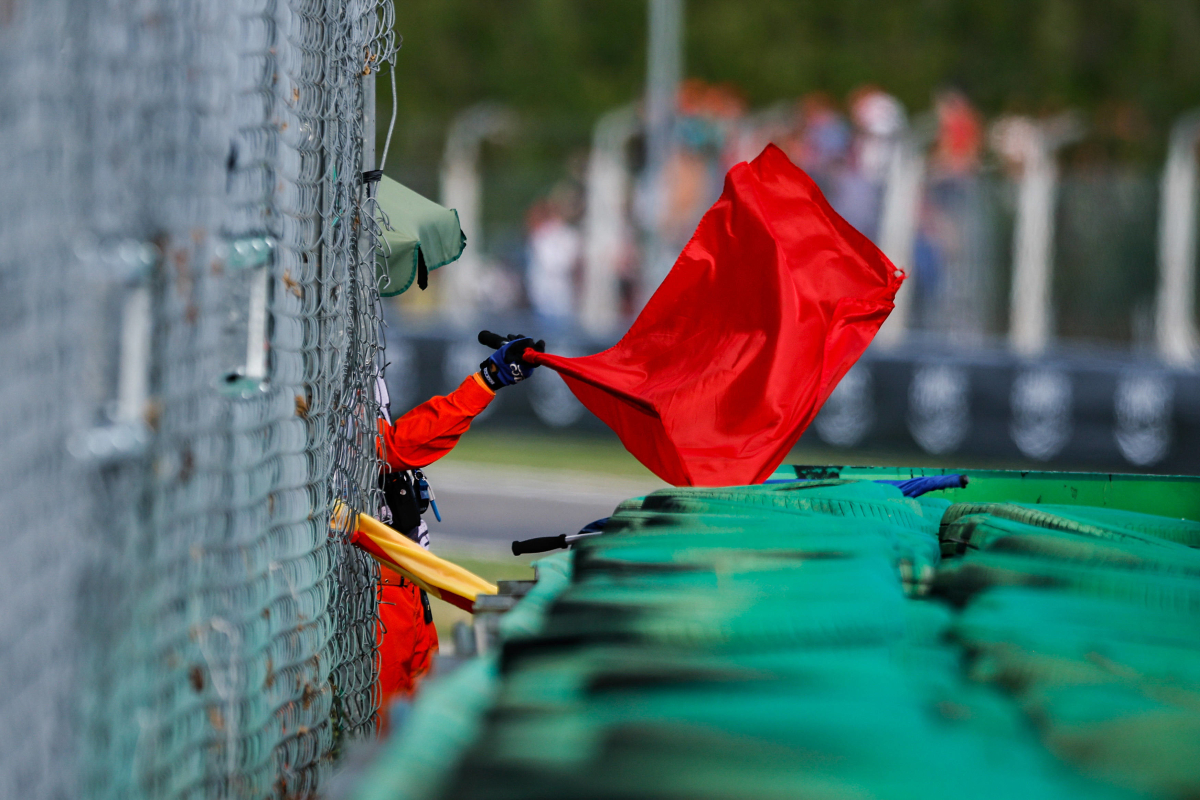
F1 Flags Explained: What do the different colours mean?
F1 Flags Explained: What do the different colours mean?

Ever wondered what those colourful flags waved by marshals mean during an F1 grand prix? GPFans got you covered!
During a grand prix, there is a silent communication that takes place between the marshals on trackside and the drivers.
READ MORE: F1 Explained: A beginner's guide to all the key terms and definitions
This communication happens through a series of flags, each with a different meaning that can influence one's race.
These ten flags are shown to drivers depending on the situation, and they convey crucial information to them - dictating everything from session restarts to emergency procedures.
Now, let's delve deeper into the ten flags that every F1 fan should know:
All 10 Flags in F1 Explained
- Yellow Flag: This flag serves as a caution sign. It warns drivers of a hazard ahead, such as an accident, debris, or a slow vehicle.
The yellow flag comes in two forms: a single-waved yellow for a hazard that is 'beside or partly on the track', and a double-waved yellow for a more serious threat - a hazard that is 'wholly or partly blocking the track' and often involving marshals on track.
In both cases, overtaking is prohibited, and drivers must slow down and be prepared to change directions or stop.
- Red Flag: This flag signifies an immediate halt to the session. It's brought out in response to serious accidents or extreme weather conditions.
Drivers must reduce their speed and return to the pits, following designated procedures based on the type of session.
- Green Flag: A sigh of relief for drivers! The green flag indicates a clear track, free from any dangers. It's used to restart sessions after a single or double-waved yellow.
- Blue Flag: Essentially a 'move over' signal, the blue flag informs a backmarker (a lapped driver) that a faster car is behind them and looking to overtake.
Backmarkers must yield a racing line at the earliest safe opportunity to avoid impeding the faster car's progress.
READ MORE: F1 Explained: How does points scoring system work?
- Black Flag: This flag carries a heavy weight. It signifies disqualification and instructs the driver to return to the pit lane immediately.
- Black and White Flag: A warning shot across the bow, the black and white flag serves as a caution for unsportsmanlike behaviour. It's displayed alongside the offending driver's number, and the driver will face a penalty if they don't change their conduct.
- Black and Orange Flag: This flag, with a black background and an orange central disc, orders a driver to return to the pits due to potential dangers arising from car damage or a mechanical issue. The car can rejoin the race only after officials deem it safe to do so.
- White Flag: This flag warns drivers of a slow vehicle ahead, acting as a pre-emptive heads-up for a potential hazard.
- Yellow and Red Flag: This flag warns drivers of a slippery surface ahead, often due to oil or water. Drivers must be cautious and reduce their speed through that section to maintain control.
- Checkered Flag: You must be familiar with this one. The checkered flag marks the end of the session, and the first driver to pass the checkered flag during a race is the winner.
READ MORE: F1 Explained: What is a pit stop and how does it work?
Related
Change your timezone:
Latest News

EXCLUSIVE: Insider claims F1 Academy and W Series couldn't co-exist
- 11 minutes ago

Wolff delivers big verdict on Hamilton behaviour
- 1 hour ago

Red Bull partner reveals HUGE F1 2026 entry details
- 2 hours ago

Hamilton salutes New York after making F1 HISTORY
- 3 hours ago

F1 Miami Grand Prix: A detailed look at Miami International Autodrome layout
- 3 hours ago

Former F1 boss SLAMS sport's major change
- Today 15:57
Related news

F1 Miami Grand Prix: A detailed look at Miami International Autodrome layout

F1 Miami Grand Prix weather forecast - latest today

Former F1 champion in surprise take over safety improvements

Why Adrian Newey is the BEST and WORST thing to happen to F1
F1 Standings

Drivers
- Oliver Bearman
- Charles Leclerc
- Carlos Sainz
- Lando Norris
- Oscar Piastri
- Pierre Gasly
- Esteban Ocon
- Sergio Pérez
- Max Verstappen
- Alexander Albon
- Logan Sargeant
- Lewis Hamilton
- George Russell
- Nico Hülkenberg
- Kevin Magnussen
- Fernando Alonso
- Lance Stroll
- Valtteri Bottas
- Zhou Guanyu
- Daniel Ricciardo
- Yuki Tsunoda
Races
-
 Gulf Air Grand Prix of Bahrain 2024
Gulf Air Grand Prix of Bahrain 2024
-
 Saudi Arabian Grand Prix 2024
Saudi Arabian Grand Prix 2024
-
 Grand Prix of Australia 2024
Grand Prix of Australia 2024
-
 MSC Cruises Grand Prix of Japan 2024
MSC Cruises Grand Prix of Japan 2024
-
 Grand Prix of China 2024
Grand Prix of China 2024
-
 Miami Grand Prix 2024
Miami Grand Prix 2024
-
 Gran Premio dell'Emilia Romagna 2024
Gran Premio dell'Emilia Romagna 2024
-
 Grand Prix of Monaco 2024
Grand Prix of Monaco 2024
-
 Grand Prix du Canada 2024
Grand Prix du Canada 2024
-
 Gran Premio de España 2024
Gran Premio de España 2024
-
 Grand Prix of Austria 2024
Grand Prix of Austria 2024
-
 Grand Prix of Great Britain 2024
Grand Prix of Great Britain 2024
-
 Grand Prix of Hungary 2024
Grand Prix of Hungary 2024
-
 Grand Prix of Belgium 2024
Grand Prix of Belgium 2024
-
 Heineken Dutch Grand Prix 2024
Heineken Dutch Grand Prix 2024
-
 Grand Prix of Italy 2024
Grand Prix of Italy 2024
-
 Grand Prix of Azerbaijan 2024
Grand Prix of Azerbaijan 2024
-
 Grand Prix of Singapore 2024
Grand Prix of Singapore 2024
-
 Grand Prix of the United States 2024
Grand Prix of the United States 2024
-
 Gran Premio de la Ciudad de Mexico 2024
Gran Premio de la Ciudad de Mexico 2024
-
 Grande Prêmio de São Paulo 2024
Grande Prêmio de São Paulo 2024
-
 Heineken Silver Las Vegas Grand Prix 2024
Heineken Silver Las Vegas Grand Prix 2024
-
 Qatar Grand Prix 2024
Qatar Grand Prix 2024
-
 Grand Prix of Abu Dhabi 2024
Grand Prix of Abu Dhabi 2024
About GPFans
GPFans is a multi-platform, multi-language brand dedicated to Formula One coverage. We bring you all the ins and outs of the sport, 24/7, everything from up-to-the-minute news and features to the latest viral stories and clips.We believe that a new generation of exciting, outspoken drivers will make F1 more popular than ever before, and we want to give our users access to as much of their heroes as possible, on and off the track. From Lewis Hamilton to Max Verstappen, Daniel Ricciardo to Sebastian Vettel, we provide in-depth analysis of every every Grand Prix in the season, from Australia to Abu Dhabi.
With Formula One under the new ownership of Liberty Media, how the sport is being covered is evolving, and GPFans will look to be at the heart of this progression into new media, as one of the fastest-growing sites covering the king of motorsports.
Follow us on your favorite social media channel
Corporate & Media
 Innovatieweg 20C
Innovatieweg 20C7007 CD, Doetinchem, Netherlands
+31645516860



















 Gulf Air Grand Prix of Bahrain 2024
Gulf Air Grand Prix of Bahrain 2024  Saudi Arabian Grand Prix 2024
Saudi Arabian Grand Prix 2024  Grand Prix of Australia 2024
Grand Prix of Australia 2024  MSC Cruises Grand Prix of Japan 2024
MSC Cruises Grand Prix of Japan 2024  Grand Prix of China 2024
Grand Prix of China 2024  Gran Premio dell'Emilia Romagna 2024
Gran Premio dell'Emilia Romagna 2024  Grand Prix of Monaco 2024
Grand Prix of Monaco 2024  Grand Prix du Canada 2024
Grand Prix du Canada 2024  Gran Premio de España 2024
Gran Premio de España 2024  Grand Prix of Austria 2024
Grand Prix of Austria 2024  Grand Prix of Hungary 2024
Grand Prix of Hungary 2024  Grand Prix of Belgium 2024
Grand Prix of Belgium 2024  Grand Prix of Azerbaijan 2024
Grand Prix of Azerbaijan 2024  Grand Prix of Singapore 2024
Grand Prix of Singapore 2024  Gran Premio de la Ciudad de Mexico 2024
Gran Premio de la Ciudad de Mexico 2024  Grande Prêmio de São Paulo 2024
Grande Prêmio de São Paulo 2024  Qatar Grand Prix 2024
Qatar Grand Prix 2024  Grand Prix of Abu Dhabi 2024
Grand Prix of Abu Dhabi 2024